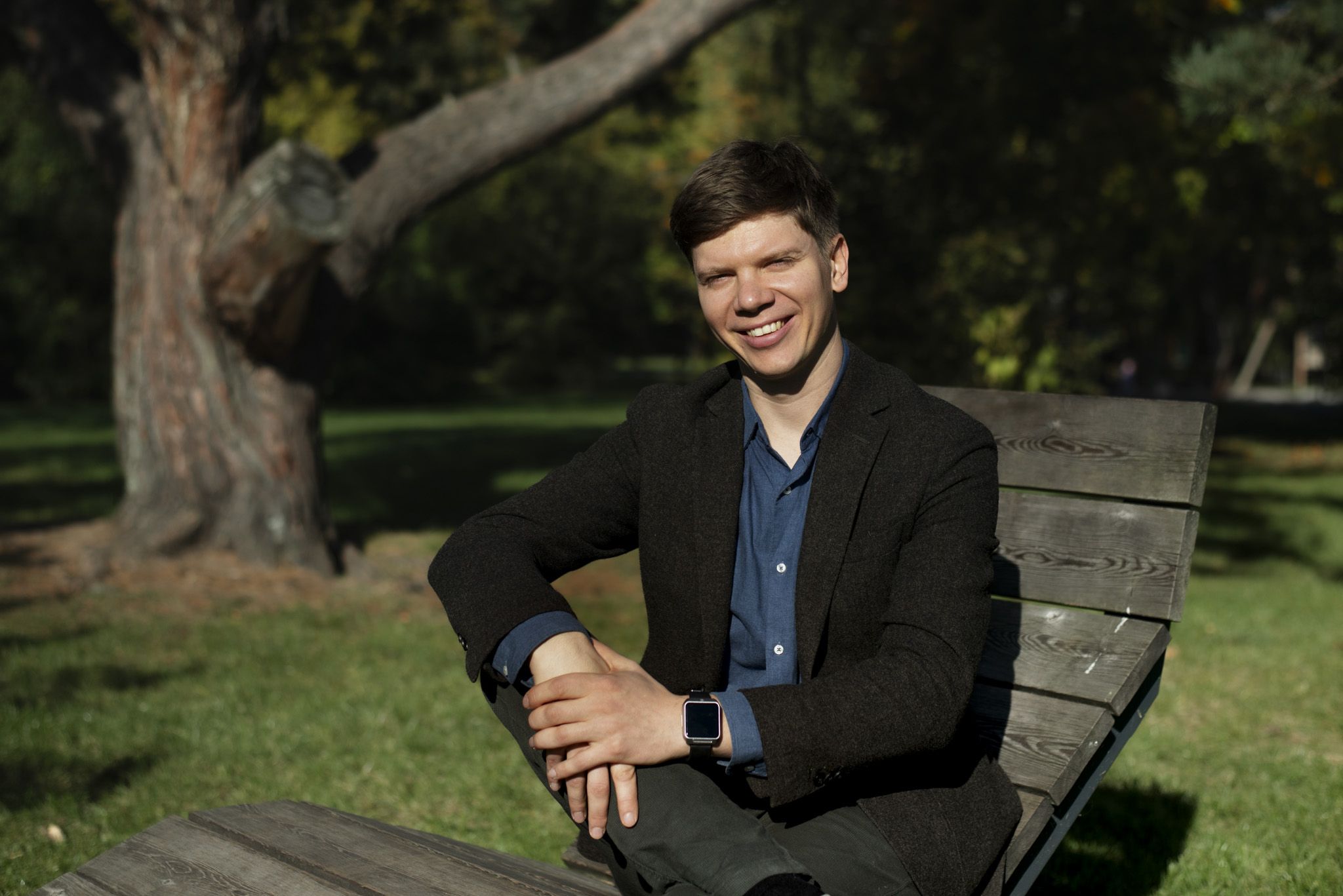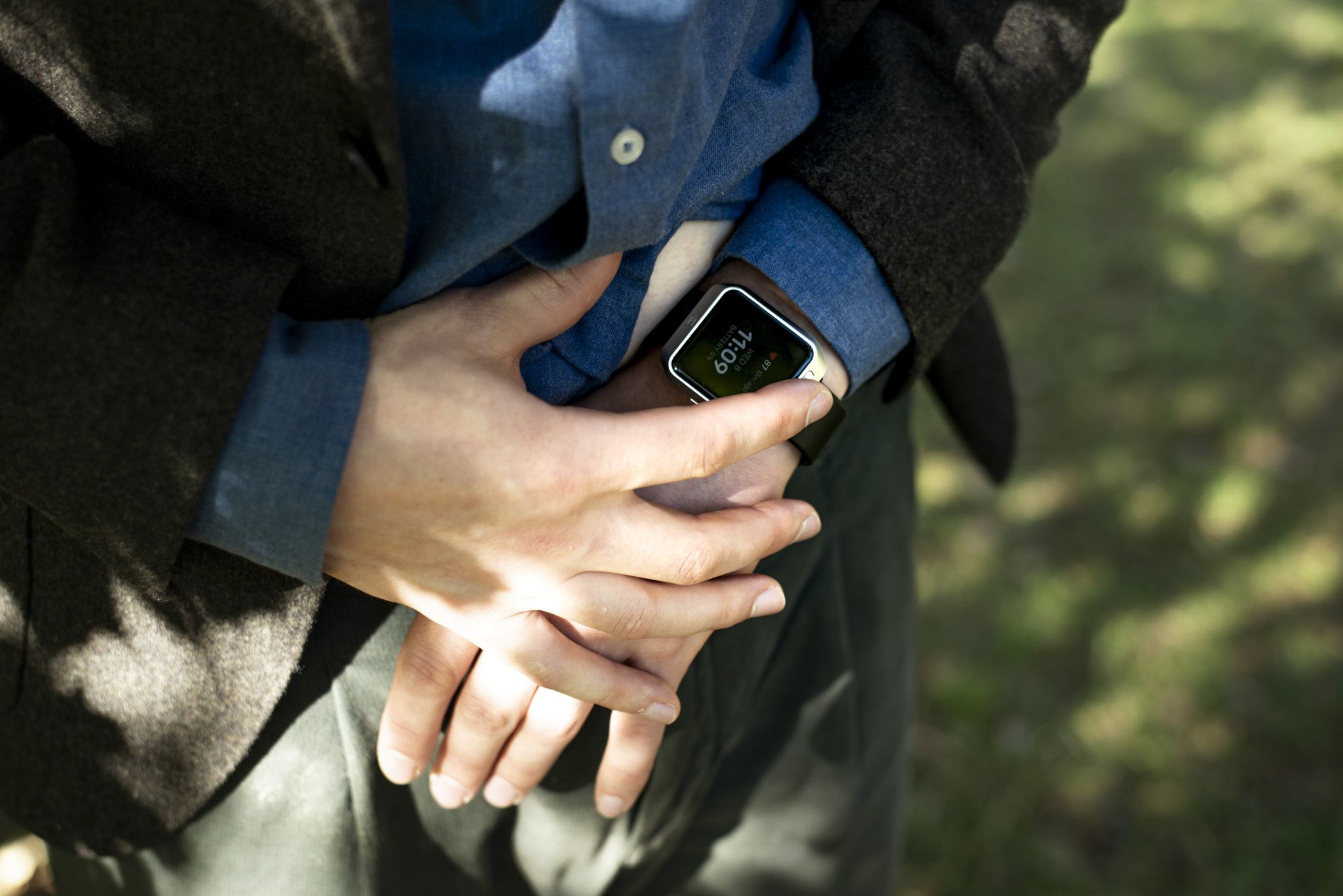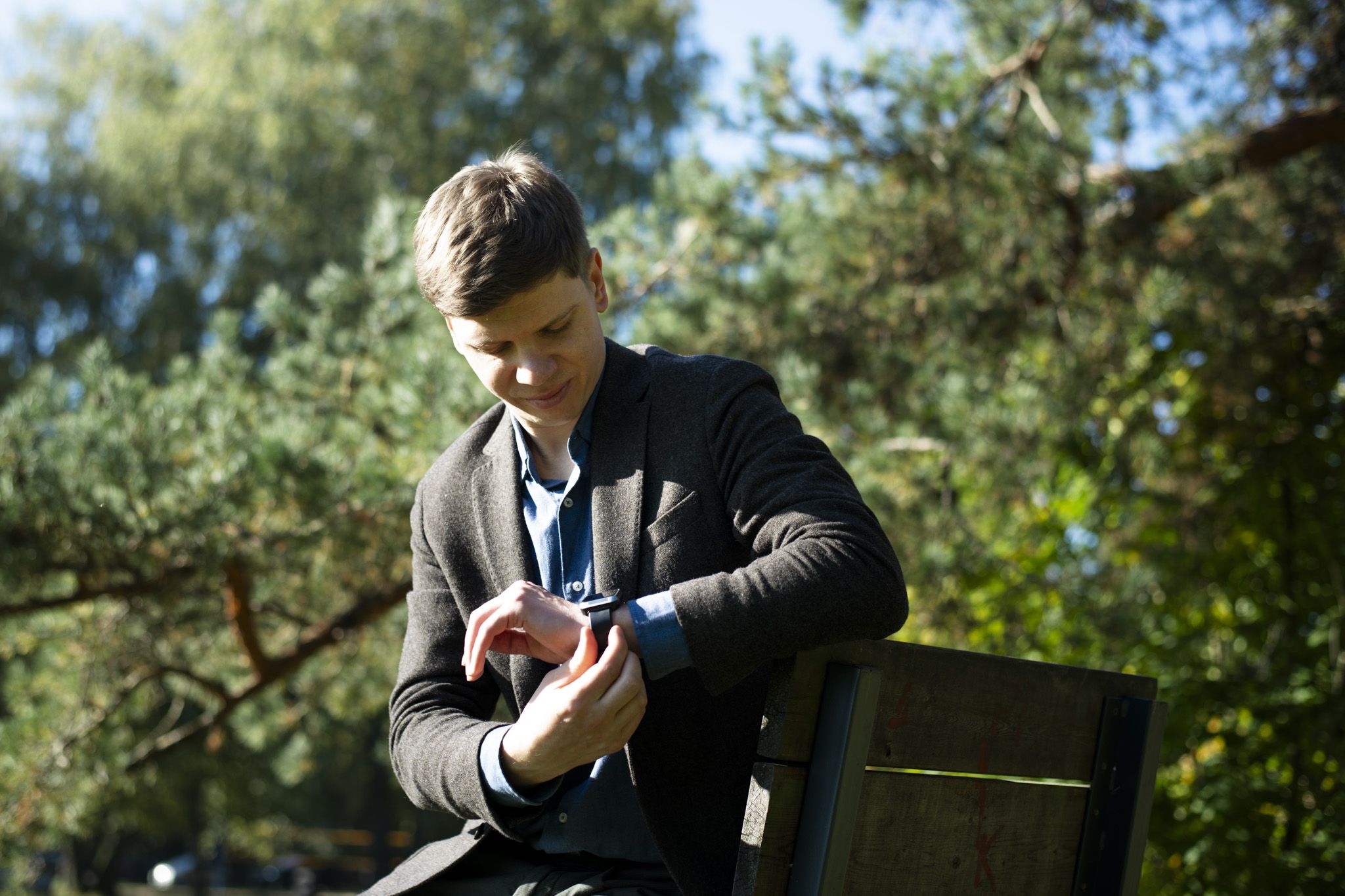A device worn on the wrist, invented by a Lithuanian cardiologist, has already saved its first life
 Dr Justinas Bacevičius / VU Faculty of Medicine
Dr Justinas Bacevičius / VU Faculty of Medicine
A new innovative solution for patients with heart rhythm disorders has arrived in Lithuanian medicine. Dr Justinas Bacevičius, a scientist at the Faculty of Medicine of Vilnius University (VU MF) and a cardiologist-electrophysiologist at the Vilnius University Hospital Santaros Klinikos, together with his colleagues, has invented and released a wrist-worn device called the TeltoHeart, which continuously monitors and records an electrocardiogram (ECG) for the patient wearing it. The device enables the detection of dangerous heart rhythm irregularities. It allows for early recognition of arrhythmias that may have a significant impact on a patient’s well-being. The effectiveness of the device has been confirmed not only by testing it on nearly 500 patients, scientifically proving its effectiveness, but also by saving its first life. This innovative device is particularly relevant in Lithuania, where heart disease is the most common cause of death. We talked to Dr Bacevičius, one of the co-creators, about the invention.
– You have extensively explored the possibilities of using a smart, wrist-worn device as a part of medical practice, and, together with your colleagues, have conducted scientific research that allows you to confidently say that the device works as expected. Tell us more about it.
– As I am a practising cardiologist and treat a great many patients in the operating theatre, I wanted to discover a practical method that would help them with their heart rhythm disorders. My journey began more than ten years ago, together with the Bioengineering Institute at Kaunas University of Technology – led by Prof. Vaidotas Marozas and his team – with Andrius Petrėnas and others, who had previously perfected the pulse wave algorithm, when we began developing a device that would record a wireless ECG. The conventional wired ECG is a well-known test: the doctor places vacuum suction cups or adhesive stickers on the patient’s chest, and within 5–7 seconds, a curve depicting the heart’s rhythm is recorded. However, disturbances to the rhythm most often occur at home, when stress can arise due to any number of circumstances, rather than in the doctor’s office. As early as 1957, Norman J. Holter had invented a monitor, where an electrode is attached to the patient’s chest to capture data for several days. The problem, however, remained, as this method cannot detect heart rhythm disturbances that occur within periods of less than once a week. I dreamed of having a device on the wrist that everyone could use to record their ECG. I suggested that the device should record not one or two, but six different curves. After implementing this in the prototype device at the outset, we ended up with a highly adaptable device. Today, it is suitable for detecting most heart conditions, including heart rhythm disorders, with the exception of myocardial infarctions.
The patient wears a device that automatically analyses pulse waves for a period of time. This helps detect high and low heart rates, as well as the most common heart disorder in the world – atrial fibrillation, which affects both the young and the old. When abnormalities are detected or the patient feels symptoms, they can instantly record their heart rhythm ECG. Disturbances in the rhythm vary and can originate from different parts of the heart, and an ECG is the most effective and only diagnostic method for detecting them. Prior to the technology available today, patients were treated based on qualified judgments and probability. For example, heart surgery was performed based on empirical evidence, and a pacemaker would be fitted or other related procedures carried out. This helped some patients, but was of no benefit to others. Cases vary greatly, so it is advisable to first perform accurate tests and only then decide what the disorder is and what treatment is required.
– How long must the patient wear this device in order to analyse the data in detail and be able to diagnose a disorder?
– It depends on the frequency of symptoms and other factors. Typically, patients wear it for a month or two, although it can be worn for a year if necessary.
– Today, when many of us have portable smart devices, one might ask what the difference is between this device and a smart watch that already measures heart rate?
– Most smart devices are designed for leisure, sports and amateur use, and are not medical devices. Many people confuse simple heart rate measurement with ECG heart rhythm monitoring, which is the most accurate diagnostic method. Some smart devices record a single-lead (curve) ECG, whereas our device records up to a six. This provides much more accurate data: not only how many times, but also how the heart muscle contracts, whether the lead is functioning normally, whether the rhythm is compensating for something that is not functioning, and from which part of the atria or ventricles the contraction comes. It is possible to detect both rare and frequent heart arrhythmias, pauses, and skipped beats, allowing the doctor to more accurately determine the origin of the disorder. Our tests have confirmed that the six-lead device adds significant diagnostic value.
Where the device is sold also tells you a lot. Devices sold in large shopping centres and electronic goods stores will not usually have full medical certification. Meanwhile, the device we have developed has undergone an extensive range of tests: both the device itself and the diagnostic methods it uses are certified.
 For the ECG recording, three areas in direct contact with the skin are touched: the abdomen, the left wrist, and the right finger / VU Faculty of Medicine
For the ECG recording, three areas in direct contact with the skin are touched: the abdomen, the left wrist, and the right finger / VU Faculty of Medicine
– Is this device comfortable for the patient to wear? After all, people wash, sleep, and exercise. What should we understand about wearing it?
– The device is waterproof, up to a depth of 100 metres. Naturally, there is a greater likelihood of motion artefacts during exercise, but I would recommend not removing the device – it is interesting to monitor your heart function during physical activity. If you suddenly need to record an ECG, you can do it immediately. The device is perfectly suitable for wearing at night, and this is recommended because episodes of irregular heart rhythm very often occur during sleep or in the early morning. It is also important to detect the relationship between heart rhythm disturbances and sleep apnoea and snoring.
Sometimes, a person may feel something physically, but after recording their ECG, we can reassure them that these are just stress-related symptoms – young people live at a tremendous pace and experience a lot of stress. At such moments, one should stop and calm down, do some breathing exercises. Conversely, a patient may not feel anything physically, but the device may show that there are serious heart rhythm disturbances that need to be treated.
– Under what conditions should patients become alert and perhaps seek out this device? What symptoms indicate that a person should be concerned about their heart function and request a referral to a cardiologist?
– This device could be prescribed to people who are unaware that they have a disorder and do not have a precise diagnosis of arrhythmia, but do experience momentary symptomatic episodes, such as a sudden, rapid heartbeat or sudden loss of consciousness. It is also relevant for obese patients, those with diabetes mellitus, hypertrophy (an enlarged heart), persistently high blood pressure, coronary heart disease, sleep disorders, and people over 65 years of age.
The device is useful for assessing the effectiveness of drug treatment or surgery for patients diagnosed with arrhythmia. Early detection of recurrence allows for medication adjustments or a review of the rhythm control strategy before more serious secondary changes develop.
An important risk group is people who have had a stroke of unknown origin. Fitting them with the device may detect atrial fibrillation, or chaos, a tremor in the heart that causes blood clotting and increases the risk of stroke fivefold. Once this has been detected, medication or surgery can be used to prevent irreversible changes in the brain. In this respect, we are a red flag on the map of Europe – we do not test enough people who have suffered a stroke of unknown origin or a transient ischaemic attack by using long-term ECG data.
– Tell us about the first case where this device helped save a life.
– A middle-aged, relatively healthy patient had been admitted to the hospital emergency room twice for the same reason – he had lost consciousness while driving. Both times, he was examined, tested and sent home without a diagnosis – all readings were normal. After the second incident, we included him in our study: we fitted him with a device and monitored his heart rate and ECG parameters. We managed to detect sudden episodes of heart rate acceleration of up to 220 beats per minute, which coincided with episodes of dizziness. Together with colleagues from the Cardiac Arrhythmia Department at Santaros Klinikos, we decided to perform surgery. During the electrophysiological examination, we detected the source of the arrhythmia and ablated the area using a catheter. The patient has now been symptom-free for three years. This is an illustrative example of how the device really works, and how accurate and timely diagnosis allows patients to be referred to the right hands to provide effective help.
Rhythm disturbances can affect anyone, including athletes, even Olympians. In young people, this can be indicated by a rapid heartbeat at rest, when this should not be happening, when they are not under stress. It should not be ignored if, when they bend over and stand up suddenly, the heart starts beating rapidly – for several seconds or longer, even for half a day. These accelerations in heart rate are sudden, can reach 180 bpm, and end just as suddenly, making them particularly difficult to record on an ECG without this new portable device. Older people are also prone to a slowing of the heartbeat, which causes dizziness and weakness. If an ECG test determines whether it is a slowing of the heartbeat or palpitations, it is easier for the doctor to determine the cause of the problem. Sometimes it is sufficient to reduce the heart rate or prescribe anti-arrhythmic drugs to make the person feel better. By selecting the appropriate patients for this extended monitoring, there will be fewer cases in which the patients will require a pacemaker to be implanted.
– Can a rapid pulse and feeling unwell be confused with a panic attack?
– Sometimes it is really difficult to distinguish these symptoms from a panic attack. Differential diagnosis can pose serious challenges for doctors, additional costs for the healthcare system and lead to unnecessary interventions for the patient. It is not appropriate to perform invasive electrophysiological testing in all cases. That is why we have developed a non-invasive device that can show whether it is a heart rhythm disorder or temporary stress with an induced physiological heart rate increase, i.e. sinus tachycardia. Without objective information or ECG test data, people with frequent arrhythmia were often prescribed sedatives, and the rhythm disorder was not diagnosed or treated. It is even more complicated if a person has both arrhythmia and anxiety about having another attack. There have been cases where heart rhythm disturbances and loss of consciousness were confused with epilepsy, but after the person had a pacemaker implanted, the “epilepsy” miraculously disappeared, revealing that it was, in fact, arrhythmia. Sometimes a person faints suddenly after jumping out of bed at night to go to the toilet, or in response to strong smells in the kitchen when they have not eaten. If they were wearing the device at the time and it managed to record their ECG just before they fainted, this would be invaluable information for both the doctor and the patient.
 Dr Justinas Bacevičius / VU Faculty of Medicine
Dr Justinas Bacevičius / VU Faculty of Medicine
– What is your vision for the future application of this device in medical practice? Will it be accessible to everyone who needs it?
– The device has already received European medical certification and is available in pharmacies and online stores. Patients can purchase it directly. It is currently used in more than thirty countries. Santaros Klinikos will also be offering this service soon. I am very pleased that our research and the device we have developed are in line with the overall vision of the Medical Science Centre of VU MF: to build bridges and establish feedback between research laboratories and the patient. More and more students, our future medical professionals, are interested in the application of the device and related research. So, progress continues to be made both in practical clinical application and in further scientific research.
– Did your doctoral studies and combining them with the highly responsible work of a cardiologist and having family life disrupt your own heart rhythm? How did you manage to balance everything during this intense period?
– I have two small children who bring joy and new meaning to my life. Although it is difficult to balance my work with family life, my beloved wife and I are gradually moving towards greater awareness and are adapting. I tell my colleagues and students that it is essential to devote part of your life to a quality personal life. I believe that universities, in addition to their usual concern for their doctoral students, should pay extra attention to those who have young children and are trying to balance this with their academic achievements. For ambitious young people, having children often coincides with their doctoral studies, which requires flexibility and an individual approach.
In clinical work, surgery is a highly responsible task that requires a lot of energy and time. A complex electrophysiological surgery can last up to five hours, during which we also experience a lot of stress. During interventions for ventricular arrhythmias, clinical deaths and resuscitations can occur – once blood flow is restored, we can then continue the surgery. This is the path chosen by doctors who specialise in cardiac interventions, so it is very important to draw a line between work and rest, between concentration at the hospital and a peaceful family life. Otherwise, the doctors themselves become patients very early on. However, electrophysiology is a team sport, and synergy with colleagues is important. I work mostly in the operating theatre; in fact, not a day goes by without surgery, and I also try to pass on my knowledge to my colleagues.
– What causes you the most concern in your work?
– The long waiting lists for patients awaiting surgery are worrying. One of the reasons for this is that the prevalence of arrhythmias in the population is steadily increasing. It takes many years to train electrophysiologists before they can perform the procedure independently. On the other hand, some people are becoming more aware and are seeking medical attention in a timely manner. We hope that our diagnostic innovations will help to specifically rule out cases that do not require surgery, enable the selection of patients who need comprehensive care, and improve the availability of services in both our cities and the regions.
– Will the waiting list become even longer if it turns out that significantly more people have disorders than previously thought?
– Yes, we may find that we are only seeing the tip of the iceberg! But in medicine, we must remember the principle of primum non nocere – first, do no harm. For example, if a person has severe anxiety disorders that could be exacerbated by wearing the device, they should not wear it. Accordingly, doctors must develop their diagnostic skills, understand innovations or even conventional ECG tests to avoid overdiagnosis. Conversely, an insufficiently detailed diagnosis can be an even worse scenario. For example, if a person only learns about their atrial fibrillation diagnosis for the first time after suffering a massive ischaemic stroke, this seriously undermines the medical profession. That is why we sought high specificity in our scientific research by producing a six-lead ECG.
– With the number of cases of heart rhythm disorders increasing and the waiting lists getting longer, has it been possible to rapidly catch up because of improved diagnostics and treatment methods?
– Indeed, the field of electrophysiology is developing rapidly and has changed beyond recognition in a relatively short period of time. More and more students are getting involved in this field. Getting to see a cardiologist in Lithuania is a real challenge, so I would like to see telemedicine continue to develop, monitoring patients remotely using devices such as this wrist-worn device. An important part of treatment is the use of artificial intelligence, which our research group is actively applying. Last year, I performed the first successful ventricular arrhythmia surgeries in the Baltic countries on patients who were in a very serious, virtually hopeless condition. They suffered from a loss of consciousness, had defibrillators implanted, and experienced life-saving discharges during arrhythmic storms. I am pleased that, by using innovative imaging methods, we were able to perform ablations on critical areas of arrhythmia and allow patients not only to survive, but also to fully regain their quality of life. Previously, this had seemed difficult to achieve.
 Dr Justinas Bacevičius / VU Faculty of Medicine
Dr Justinas Bacevičius / VU Faculty of Medicine
– You have mentioned that you like to spend your free time in nature. How important are physical activity and being in nature in the lives of people who are prone to heart disease? Can such activities help the human heart and prevent medical interventions and treatment?
– I even joke that we should prescribe people to love themselves (not just care for others), ride bicycles and walk in the woods. People no longer know how to just do nothing. They always want to surf the internet or work, so they are exposed to an environment full of external stimuli. Although medicine is improving every year, we should not only treat the consequences, but also look for acceptable ways to improve our health, such as mindful breathing, self-reflection and meditation. Science has proven that this slows down the pulse, and for some people, that alone is sufficient to help forget about their heart rhythm disorders. I recommend going on hikes, walks, foraging for mushrooms and berries, just don’t get lost in the forest, or the hard-earned peace will vanish in a heartbeat.